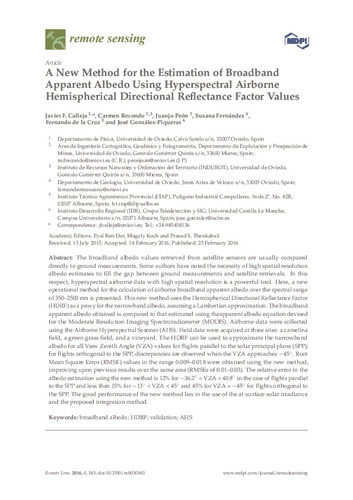A New Method for the Estimation of Broadband Apparent Albedo Using Hyperspectral Airborne Hemispherical Directional Reflectance Factor Values
Palabra(s) clave:
broadband albedo
HDRF
validation
AHS
Fecha de publicación:
Editorial:
MDPI
Versión del editor:
Citación:
Descripción física:
Resumen:
The broadband albedo values retrieved from satellite sensors are usually compared directly to ground measurements. Some authors have noted the necessity of high spatial resolution albedo estimates to fill the gap between ground measurements and satellite retrievals. In this respect, hyperspectral airborne data with high spatial resolution is a powerful tool. Here, a new operational method for the calculation of airborne broadband apparent albedo over the spectral range of 350–2500 nm is presented. This new method uses the Hemispherical Directional Reflectance Factor (HDRF) as a proxy for the narrowband albedo, assuming a Lambertian approximation. The broadband apparent albedo obtained is compared to that estimated using theapparent albedo equation devised for the Moderate Resolution Imaging Spectroradiometer (MODIS). Airborne data were collected using the Airborne Hyperspectral Scanner (AHS). Field data were acquired at three sites: a camelina field, a green grass field, and a vineyard. The HDRF can be used to approximate the narrowband albedo for all View Zenith Angle (VZA) values for flights parallel to the solar principal plane (SPP); for flights orthogonal to the SPP, discrepancies are observed when the VZA approaches -45º. Root Mean Square Error (RMSE) values in the range 0.009–0.018 were obtained using the new method, improving upon previous results over the same area (RMSEs of 0.01–0.03). The relative error in the albedo estimation using the new method is 12% for -36.2º < VZA < 40.8º in the case of flights parallel to the SPP and less than 15% for -13º < VZA < 45º and 45% for VZA = -45º for flights orthogonal to the SPP. The good performance of the new method lies in the use of the at-surface solar irradiance and the proposed integration method.
The broadband albedo values retrieved from satellite sensors are usually compared directly to ground measurements. Some authors have noted the necessity of high spatial resolution albedo estimates to fill the gap between ground measurements and satellite retrievals. In this respect, hyperspectral airborne data with high spatial resolution is a powerful tool. Here, a new operational method for the calculation of airborne broadband apparent albedo over the spectral range of 350–2500 nm is presented. This new method uses the Hemispherical Directional Reflectance Factor (HDRF) as a proxy for the narrowband albedo, assuming a Lambertian approximation. The broadband apparent albedo obtained is compared to that estimated using theapparent albedo equation devised for the Moderate Resolution Imaging Spectroradiometer (MODIS). Airborne data were collected using the Airborne Hyperspectral Scanner (AHS). Field data were acquired at three sites: a camelina field, a green grass field, and a vineyard. The HDRF can be used to approximate the narrowband albedo for all View Zenith Angle (VZA) values for flights parallel to the solar principal plane (SPP); for flights orthogonal to the SPP, discrepancies are observed when the VZA approaches -45º. Root Mean Square Error (RMSE) values in the range 0.009–0.018 were obtained using the new method, improving upon previous results over the same area (RMSEs of 0.01–0.03). The relative error in the albedo estimation using the new method is 12% for -36.2º < VZA < 40.8º in the case of flights parallel to the SPP and less than 15% for -13º < VZA < 45º and 45% for VZA = -45º for flights orthogonal to the SPP. The good performance of the new method lies in the use of the at-surface solar irradiance and the proposed integration method.
ISSN:
DOI:
Patrocinado por:
The research leading to these results has received funding from the European Community’s 7th Framework Program (FP7/2008-2013) under EUFAR contract No. 27159, Cost Action ES0903-EUROSPEC and ESA Grant D/EOP/rp/2012/48.
Colecciones
- Artículos [36410]
- Física [1969]
- Indurot [170]
- Investigaciones y Documentos OpenAIRE [8058]
Ficheros en el ítem





